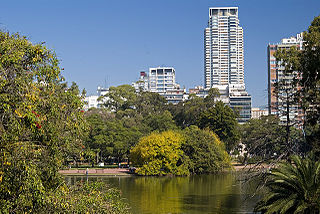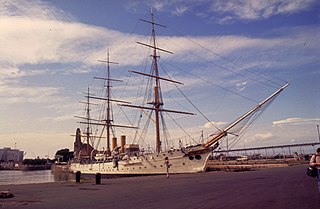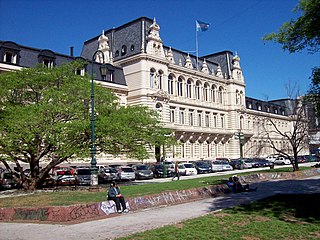
The Casa Rosada is the executive mansion and office of the President of Argentina. The palatial mansion is known officially as Casa de Gobierno. Normally, the President lives at the Quinta de Olivos, the official residence of the President of Argentina, which is located in Olivos, Greater Buenos Aires. The characteristic color of the Casa Rosada is baby pink, and is considered one of the most emblematic buildings in Buenos Aires. The building also houses a museum, which contains objects relating to former presidents of Argentina. It has been declared a National Historic Monument of Argentina.

Belgrano is a leafy, northern barrio or neighborhood of the city of Buenos Aires, Argentina.

San Juan is the capital city of the Argentine province of San Juan in the Cuyo region, located in the Tulúm Valley, west of the San Juan River, at 650 m (2,133 ft) above mean sea level, with a population of around 112,000 as per the 2001 census [INDEC].

Morón is a city in the Argentine province of Buenos Aires, capital of the Morón partido, located in the Greater Buenos Aires metropolitan area, at 34°39′S58°37′W. Located 20 km (13 mi) west of Downtown Buenos Aires, Morón is easily reached via bus along Avenida Rivadavia, via National Highway 7, and the Sarmiento railway line.

Caballito is a barrio (neighborhood) of the Argentine capital, Buenos Aires. It is the only barrio in the administrative division Comuna 6.

Parque Tres de Febrero, popularly known as Bosques de Palermo, is an urban park of approximately 400 hectares located in the neighborhood of Palermo in Buenos Aires, Argentina. Located between Libertador and Figueroa Alcorta Avenues, it is known for its groves, lakes, and rose gardens.

Flores is a middle-class barrio or district in the center part of Buenos Aires city, Argentina. Flores was considered a rural area of the Province of Buenos Aires until 1888 when it was integrated into the city. Flores is the place of birth of Pope Francis.

The Palais de Glace is a rumeno style Belle Époque building in the Recoleta neighbourhood of Buenos Aires, Argentina.

The Pirámide de Mayo, located at the hub of the Plaza de Mayo, is the oldest national monument in the City of Buenos Aires. Its construction was ordered in 1811 by the Primera Junta to celebrate the first anniversary of the May Revolution. It was renovated in 1856, under the direction of Prilidiano Pueyrredón. In 1912, after having undergone many modifications, it was moved 63 metres to the east, with the idea that a much larger monument would eventually be constructed around it.

The Tigre Club stands on the banks of the Luján River, in Paseo Victorica, Tigre, near Buenos Aires, Argentina. The club, built next to the Tigre Hotel, was financed by Ernesto Tornquist and was designed by the architects Pablo Pater, Luis Dubois and the engineer Emilio Mitre ; it was opened on 13 January 1912. Like the hotel nearby opened in 1890, the Tigre Club soon became an important meeting place for the rich and famous. The elegant and luxurious building has two floors with mezzanines with large windows on almost all sides. The main saloon on the first floor has frescoes by the Spanish artist Julio Vila y Prades (1875-1930), the staircases are of marble and there are Venetian mirrors and French chandeliers.

Villa Luro is a barrio (district) of Buenos Aires, Argentina. It is located near the western end of the City of Buenos Aires.

The Museo Mitre (Spanish) in Buenos Aires, Argentina, is a museum dedicated to Argentine history, as well as to the legacy of President Bartolomé Mitre.

Avenida Figueroa Alcorta is a major thoroughfare in Buenos Aires, Argentina, with a length of over 7 km (4.3 mi) along the city's northside.

ARA Presidente Sarmiento is a museum ship in Argentina, originally built as a training ship for the Argentine Navy and named after Domingo Faustino Sarmiento, the seventh President of Argentina. She is considered to be the last intact cruising training ship from the 1890s.

The Sarmiento Palace, commonly known as the "Pizzurno Palace", is an architectural landmark in the Recoleta section of Buenos Aires and the location of the Argentine Ministry of Education.

Hotel de Inmigrantes is a complex of buildings constructed between 1906 and 1911, in the port of Buenos Aires, Argentina, to receive and assist the many thousands of immigrants who were arriving in Argentina from many parts of the world. The hotel ceased to function in 1953, was declared a National Monument in 1995 and today houses the National Museum of Immigration and the Tres de Febrero National University Museum (MUNTREF) a.k.a. Contemporary Art Centre.

The Museo Histórico Sarmiento Sarmiento History Museum, located in the Buenos Aires neighborhood of Belgrano, is a museum dedicated to Argentine history, and in particular to the Generation of '80 and the life of President Domingo Faustino Sarmiento, a writer and political figure who was President of Argentina between 1868 and 1874. There are also sections that show the literary works of Nicolás Avellaneda, his presidential successor and about the revolution caused by the federalization of Buenos Aires in 1880, when the national government had to abandon its location in downtown Buenos Aires and move to the building where the museum is today in Belgrano, then the outskirts of the city.

The Monument to the Carta Magna and Four Regions of Argentina is located in the intersection of Del Libertador and Sarmiento Avenues, a landmark in the Palermo neighbourhood of Buenos Aires, Argentina. It is commonly referred to as the "Monument of the Spanish"

Avenida General Sarmiento is an avenue located in the Palermo neighborhood, in Buenos Aires, Argentina. It runs from Plaza Italia to the Costanera Rafael Obligado Avenue, across the Parque Tres de Febrero.



















